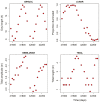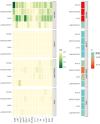Lunar-linked biological rhythms in the immune system of freshwater three-spined stickleback
- PMID: 38863794
- PMCID: PMC11165434
- DOI: 10.1093/discim/kyae007
Lunar-linked biological rhythms in the immune system of freshwater three-spined stickleback
Erratum in
-
Correction to: Lunar-linked biological rhythms in the immune system of freshwater three-spined stickleback.Discov Immunol. 2024 Jul 15;3(1):kyae012. doi: 10.1093/discim/kyae012. eCollection 2024. Discov Immunol. 2024. PMID: 39011522 Free PMC article.
Abstract
Immune responses are widely accepted to be under circadian regulation via a molecular clock, with many practical consequences, but much less is known of how other biological rhythms could affect the immune system. In this study, we search for lunar rhythms (circalunar, circasemilunar, and circatidal cycles) in the immune expression of the recently marine-derived freshwater fish, the low-plate morph of the three-spined stickleback. We employed time series of immune expression (mRNA) measurements for 14 immune-associated genes, representing a variety of immunological pathways. Times series measurements were taken on fish populations in the wild, in seminatural outdoor mesocosms, and in the laboratory, according to sampling regimens originally designed to study circannual variation but with the additional potential to provide information about lunar variation. Our evidence best supported the existence of a very small endogenous tidal rhythm. This is consistent with previous suggestions of the existence of a primordial tidal endogenous clock, some elements of which may be conserved in animals evolving outside the marine environment.
Keywords: immunity; lunar; three-spined stickleback; tidal; ultradian.
© The Author(s) 2024. Published by Oxford University Press on behalf of the British Society for Immunology.
Conflict of interest statement
None declared.
Figures








Similar articles
-
Tidally rhythmic behaviour of marine animals.Symp Soc Exp Biol. 1985;39:63-93. Symp Soc Exp Biol. 1985. PMID: 3914727 Review.
-
Plasticity of circadian and circatidal rhythms in activity and transcriptomic dynamics in a freshwater snail.Heredity (Edinb). 2024 May;132(5):267-274. doi: 10.1038/s41437-024-00680-7. Epub 2024 Mar 27. Heredity (Edinb). 2024. PMID: 38538720 Free PMC article.
-
The Still Dark Side of the Moon: Molecular Mechanisms of Lunar-Controlled Rhythms and Clocks.J Mol Biol. 2020 May 29;432(12):3525-3546. doi: 10.1016/j.jmb.2020.03.009. Epub 2020 Mar 19. J Mol Biol. 2020. PMID: 32198116 Free PMC article. Review.
-
An Overview of Monthly Rhythms and Clocks.Front Neurol. 2017 May 12;8:189. doi: 10.3389/fneur.2017.00189. eCollection 2017. Front Neurol. 2017. PMID: 28553258 Free PMC article. Review.
-
Towards an Understanding of Circatidal Clocks.Front Physiol. 2022 Feb 25;13:830107. doi: 10.3389/fphys.2022.830107. eCollection 2022. Front Physiol. 2022. PMID: 35283768 Free PMC article.
Cited by
-
Context matters: Immunology meets ecology.Discov Immunol. 2025 Mar 4;4(1):kyaf003. doi: 10.1093/discim/kyaf003. eCollection 2025. Discov Immunol. 2025. PMID: 40190591 Free PMC article. No abstract available.
References
-
- Kaiser TS, Neumann J. Circalunar clocks—old experiments for a new era. Bioessays 2021, 43, 2100074. - PubMed
LinkOut - more resources
Full Text Sources
